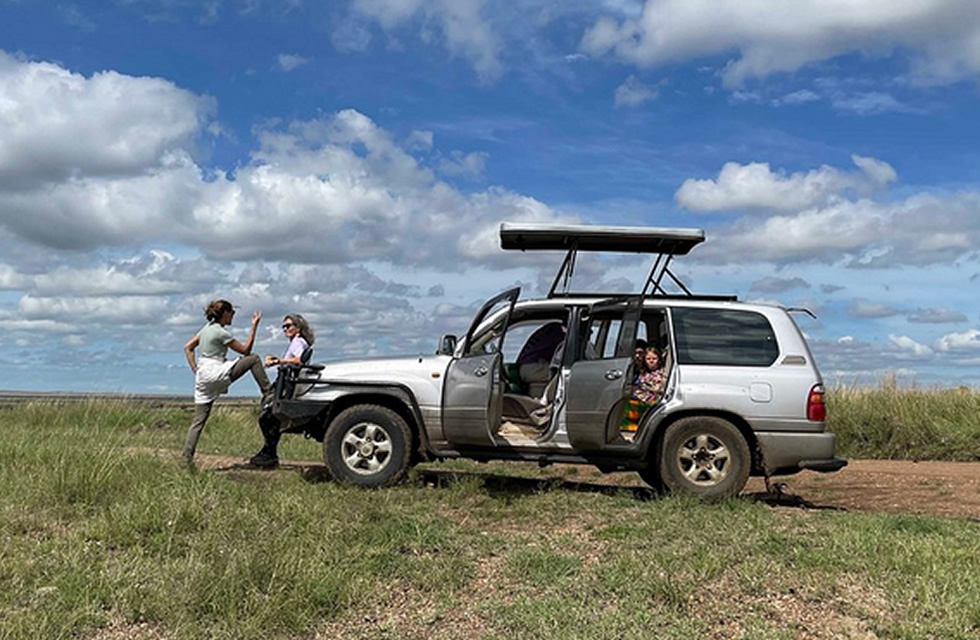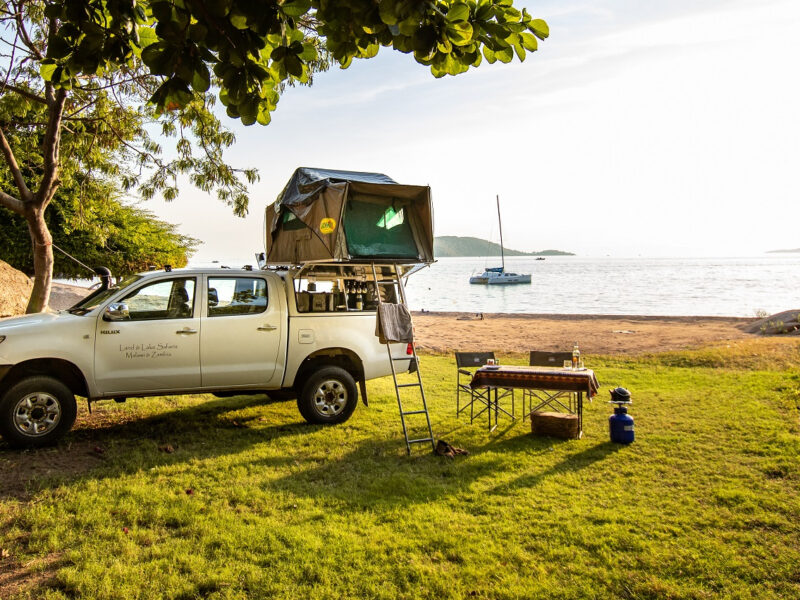
Ultimate Guide to Driving a Rental Car in Uganda
Our legendary road trip Uganda is one of our favorite trips EVER and renting a car in Uganda was an essential part of our itinerary. After all, four wheels are a must have when you’re planning a road trip through three countries! We had huge plans for our rental car: a 3 week drive from Kampala taking in Bwindi impenetrable National Park, Murchison Falls, Tree climbing lions of Queen Elizabeth National Park and the incredible Ssesse Island beaches in the middle of Lake Victoria. Having driven over 4,000km on Uganda’s roads we wanted to share everything we learned about driving in the country to help you plan your trip. Here are our top tips for driving in Uganda!
Choosing a rental car
Rent the biggest car you can afford if you’re traveling for more than a few days. The vastness of the country means you are going to spend many, many hours in the car and it is more than worth it to spend a little extra for some comfort. We, as three adults, shared a Toyota Land Cruiser customized for safaris with a pop up roof, and it was perfect for a longer haul Gorilla trip. The tinted windows meant our luggage wasn’t too visible in the trunk and we had plenty of leg room during the trip.
Consider a 4×4 if you are tempted to go off-road. We ended up taking some hilly terrains, something which was only possible with a 4×4. We also encountered a number of roads which would likely be uncomfortable in a regular car due to their very poor condition.
Uganda Driving Etiquette
Driving is on the left hand side in Uganda and almost all vehicles are left hand. This is because the country was once a British protectorate.
Almost on the entire trip we generally found Uganda drivers to be very courteous and everyone we met on the way was very considerate when over taking and changing lanes.
When driving on a single lane road move to the left into the hard shoulder to let cars past. This can be quite counter-intuitive as a foreign driver but it was a common occurrence and caused us to sweat profusely when it happened on the brow of a hill!
If you wish to pass a slower moving vehicle indicate to the right and the car in front will typically move in when possible.
Climbing lanes are often available as the Uganda roads are quite hilly especially in the southern part of the country and there are lots of large trucks and Lorries. Use them to pass trucks and slow-moving vehicles when going uphill. If you are moving slowly than the traffic, move into the left lane to let traffic overtake.
Once you pass another driver a flash of the hazard lights suffices as a thank you. You’ll usually be greeted by a friendly flash of their headlights. It’s a friendly gesture so don’t be alarmed when it first happens!
Honking the horn is strictly prohibited in any national park and fined if you do it except in an emergency. We only heard a horn twice and definitely not in the park on both occasions the drivers were almost in an accident situation.
Watch out for the stop signs! Being used to driving in the US and Europe the stop signs on the main roads through the towns took us by surprise. Be sure to come to a complete halt at the stop sign and give way to cars along the main road onto the main road.
Driving Directions
A GPS is essential. We used an offline GPS app which we have on our cellphones and, on occasion, used the data on the local phone lines we purchased at the beginning of our trip. Our GPS was equipped with speed limits which although sometimes out of date, was useful for the ever-changing speed limits we met.
Double check your route before you start and have a general idea of the route before you set out each day. This is important especially when using the country roads. Sometimes the GPS suggested off-road conditions because the distance was shorter but don’t be tempted by the shorter predicted times as the roads can be horrific!
Driving at night
The number one rule is to avoid driving after dark whenever possible! Our car rental company advised us of this a number of times when we picked up our car. There are a number of reasons for this:
Outside of Kampala there were lots of people walking and running on the hard shoulder after dark and it was almost impossible to see them with the head lamps as they didn’t typically wear any reflective gear. It is especially common to see walkers in and around the townships.
Lots of animals come out at night and it is a huge driving hazard. We came across so many herds of goats and cows wandering on the road and it would not have been pleasant to hit them!
Many of the roads, including the main highways, did not have fluorescent line markings or cats-eyes. This makes driving after dark particularly difficult as it can be difficult to see the road!
Despite these warnings we actually ended up doing quite a lot of night driving as our itinerary was so jam-packed and we underestimated some of the driving distances. We encountered all of the above as well as an incredibly foggy mountain pass and it made for very stressful evenings!
Speed Limits in Uganda
Watch your speed! We noticed that the Uganda drivers rarely, if ever, broke the speed limit.
The police presence was very heavy in most areas of our trip, particularly on the Garden Route portion of the drive. This meant there were mobile speed cameras setup everywhere and we found cruise control invaluable for staying within the speed limit. Fixed speed cameras were prevalent in Cape Town and we saw a number of them during our time there.
The speed limit varies frequently and it was common to go through zones of 50, 80 and 100 km/h interchangeably. Driving through most of trading centers and towns strictly keep 50km/h follow the sign posts on the highways
Road Conditions in Uganda
Generally speaking the roads were very good throughout all of Uganda, especially the western routes to the African standard. The roads in Rwanda from the Katuna Pass to Kigali were, somewhat surprisingly, excellent due to the new road upgrade. The Northern roads were fine but we did encounter some patches poorly maintained roads. There are of course a number of caveats to these:
The Katuna pass road has a fantastic new surface on the Rwanda border side; however the road is still 4×4 only between the Kyanika border and the Uganda entry point. Only 4×4’s will be allowed to enter, you have been warned!
There were occasional long stretches of road works. Outside of Kampala we passed at least 10 instances where roads or lanes were closed because of temporary and road works. This can drastically increase your drive time!
On many occasions we came across roads in quite bad condition in the rural areas. Potholes, dust roads and roads without line markings were relatively common on our road trip through the country.
Gas Station stops
Fuel/Petrol stations were available frequently during our drives throughout the country. The only exception to this was up-country in the northern part of the country where we didn’t pass a single major fuel/petrol station on our drive. We had read this before we travelled and planned accordingly. The stations were less frequent on the Northern side of Uganda but were not sparse enough for us to be concerned about the distances.
Don’t fill your own car. There are petrol attendants at all the fuel stops who will fill you up, bring the credit card machine and wash your windows as you wait. If you need it any way, they can check your oil, water and tyre pressure. As a tourist, it’s customary to tip a small amount such as $5 for the service.
Parking Security
We loved the parking attendants who were present in the car parks at all the popular spots. A small tip e.g. 2000shs was sufficient and we felt very secure leaving our car. In Kampala there were official parking attendants on most streets, charging a standard price for parking and monitoring.
Use common sense when a parking attendant isn’t around. Do not leave anything visible in the car. We were warned on multiple occasions by locals about this. We didn’t have any bad experiences; however they warned that even leaving a charging cable visible was enough to increase the risk of a break in.
Driving in other African Countries
Most of the major rental companies allow their cars to be driven into Rwanda, Kenya, Tanzania, Southern Sudan, Burundi and D.R. Congo. For Rwanda you drive on the right and for most of the highways keep the speed at 40km/h
If you are considering driving outside of Uganda be sure to mention it to your rental company when you pick up your car. We rented our self-drive Safari Car from Rent a Car in Uganda and received a letter (free of charge) which gave us permission to enter Rwanda and Tanzania with the rental car. These letters were required at the borders. We were still liable for the vehicle border crossing fees.
